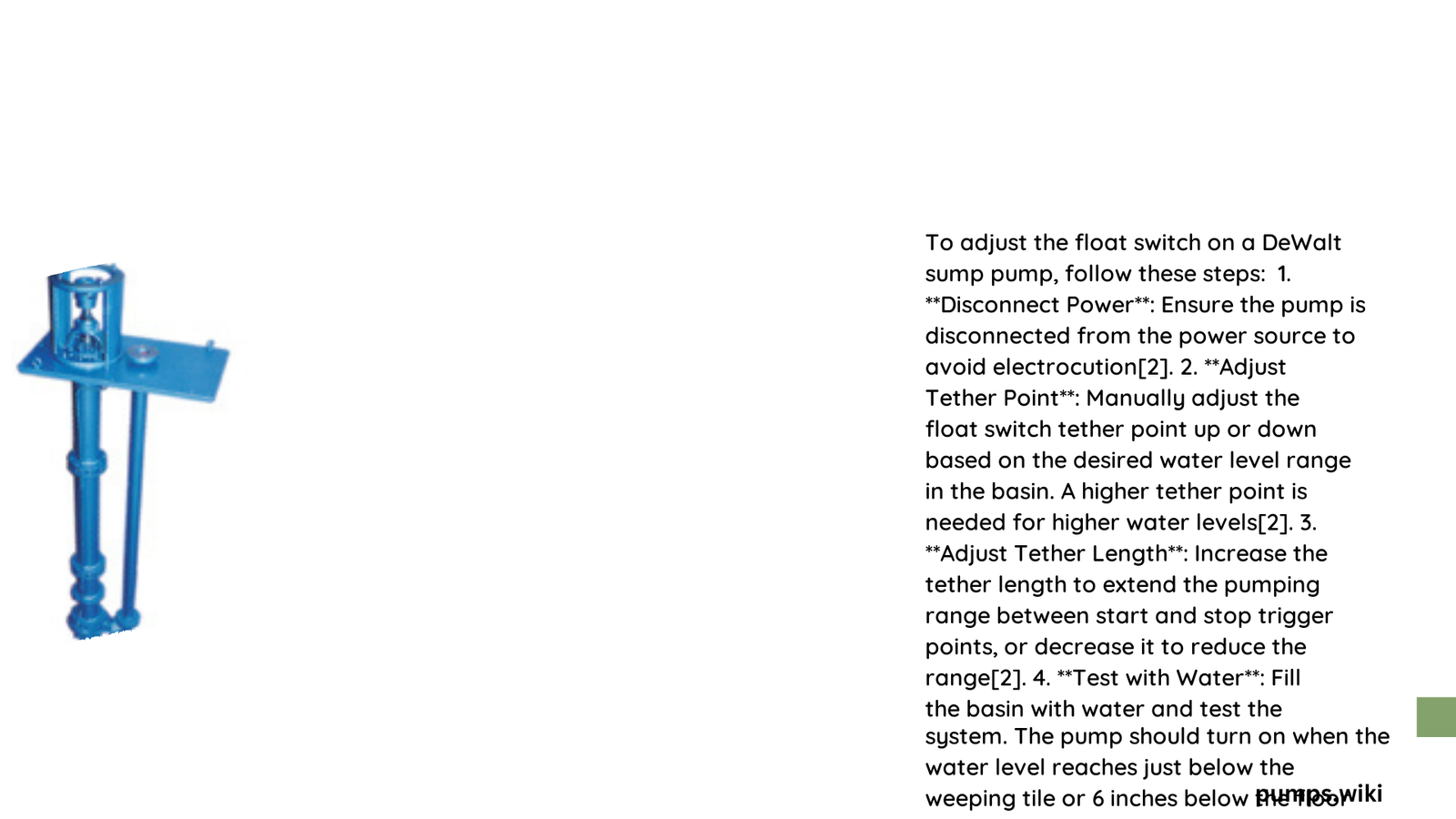DeWalt sump pump float adjustment is a crucial process for maintaining optimal pump performance and preventing basement flooding. This guide provides detailed steps for adjusting the float switch on DeWalt sump pumps, ensuring proper activation and deactivation based on water levels. By following these instructions, homeowners can effectively calibrate their sump pump system, maximizing efficiency and protecting their property from water damage.
What is the Purpose of DeWalt Sump Pump Float Adjustment?
The float switch on a DeWalt sump pump serves as the primary mechanism for controlling when the pump activates and deactivates. Proper adjustment of this float is essential for:
- Preventing premature pump activation
- Ensuring the pump runs long enough to adequately remove water
- Avoiding unnecessary pump cycling, which can lead to increased wear and tear
By fine-tuning the float adjustment, you can optimize your sump pump’s performance and extend its lifespan.
How to Adjust the Float Switch on a DeWalt Sump Pump?

Follow these steps to properly adjust the float switch on your DeWalt sump pump:
-
Disconnect Power: Always prioritize safety by unplugging the pump before making any adjustments.
-
Locate the Float Switch: Identify the float switch, typically a buoyant ball or cylinder attached to the pump.
-
Adjust Tether Point: For tethered float switches, modify the tether point’s position to set the desired water level for pump activation.
-
Adjust Tether Length: Increase or decrease the tether length to control the range between pump start and stop points.
-
Ensure Free Movement: Verify that the float can move freely without obstruction throughout its range of motion.
-
Test the System: Reconnect power and test the adjustment by adding water to the sump pit, observing the pump’s activation and deactivation points.
What Are the Recommended Water Levels for DeWalt Sump Pump Activation?
While exact measurements may vary depending on your specific setup, here are general guidelines for setting water levels:
| Action | Recommended Water Level |
|---|---|
| Pump Activation | 6 inches below floor level |
| Pump Deactivation | Nearly empty, with inlet screen covered |
These settings help prevent flooding while ensuring the pump doesn’t run dry, which can damage the motor.
How to Troubleshoot Common DeWalt Sump Pump Float Issues?
If you’re experiencing problems with your DeWalt sump pump float, consider these troubleshooting steps:
- Pump Not Activating:
- Check for obstructions preventing float movement
- Verify power connection and circuit breaker status
-
Ensure tether point is set at the correct height
-
Pump Running Continuously:
- Adjust tether length to allow proper deactivation
- Check for debris keeping the float elevated
-
Inspect the float switch for damage or malfunction
-
Inconsistent Pump Operation:
- Clean the float switch to remove any buildup
- Verify the float’s range of motion is unobstructed
- Consider replacing the float switch if issues persist
What Tools Are Needed for DeWalt Sump Pump Float Adjustment?
Fortunately, adjusting a DeWalt sump pump float typically requires minimal tools:
- Screwdriver (flathead or Phillips, depending on pump model)
- Pliers (for adjusting tether clamps, if applicable)
- Bucket (for testing pump activation)
- Flashlight (for better visibility in the sump pit)
Having these tools on hand will make the adjustment process smoother and more efficient.
How Often Should DeWalt Sump Pump Float Adjustment Be Performed?
Regular maintenance of your DeWalt sump pump, including float adjustment, is crucial for optimal performance. Consider the following schedule:
- Quarterly Checks: Inspect the float switch and its operation every three months.
- Bi-Annual Adjustments: Perform a thorough float adjustment twice a year, ideally before periods of heavy rainfall.
- Post-Storm Verification: After significant weather events, verify proper float function and adjust if necessary.
- Annual Professional Inspection: Have a plumbing professional assess your entire sump pump system yearly.
Adhering to this schedule can help prevent unexpected failures and extend the life of your sump pump.
What Are the Consequences of Improper DeWalt Sump Pump Float Adjustment?
Failing to properly adjust your DeWalt sump pump float can lead to several issues:
- Basement Flooding: If the float is set too high, the pump may not activate in time to prevent flooding.
- Pump Burnout: A float set too low can cause the pump to run dry, potentially damaging the motor.
- Increased Energy Costs: Improper adjustment may lead to unnecessary pump cycling, consuming more electricity.
- Reduced Pump Lifespan: Frequent short-cycling or extended dry runs can significantly shorten the pump’s operational life.
- Water Damage: Ineffective pumping due to poor float adjustment can result in water damage to basement walls, floors, and stored items.
How to Maintain Your DeWalt Sump Pump Float for Longevity?
To ensure your DeWalt sump pump float continues to function properly over time, follow these maintenance tips:
- Regular Cleaning: Remove any debris or mineral buildup from the float switch.
- Lubrication: If recommended by the manufacturer, apply a water-resistant lubricant to moving parts.
- Inspect for Wear: Check the float and tether for signs of degradation or damage.
- Test Functionality: Periodically activate the float manually to ensure smooth operation.
- Keep Records: Document all maintenance and adjustments for future reference.
By following these guidelines, you can maximize the lifespan and reliability of your DeWalt sump pump float switch.
Remember, proper DeWalt sump pump float adjustment is key to maintaining a dry basement and protecting your home from water damage. Regular maintenance and timely adjustments will ensure your sump pump system operates efficiently when you need it most.
References:
1. Boshart Support: Setting the Tether Point and Tether Length on a Sump Pump Float Switch
2. DeWalt Pumps Manual: DXWP62383, DXWP62381, DXWP62389, etc.
3. DeWalt 1-2 HP Sump Pump: Stainless Steel/Cast Iron Submersible Sump Pump
